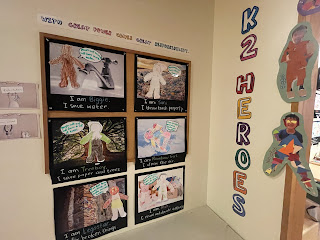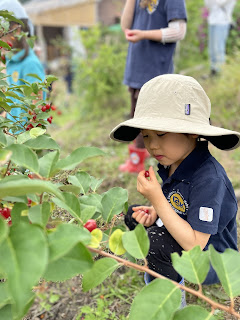34: Celebrate the Learning
"Tell me and I forget. Teach me and I remember. Involve me and I learn."
-Benjamin Franklin
Kindergarten marks a crucial milestone in a child's educational journey. It is a year filled with discovery, growth, and foundational learning experiences. Celebrating the learning journey in kindergarten is of utmost importance, as it recognizes the achievements, progress, and joy that children have experienced throughout the year.
This week, the children prepared to celebrate their kindergarten journey by planning and practicing for the student-led conferences.
The student-led conferences play an integral part of the IB programme. It serves as an opportunity for the children, parents, and teachers to celebrate each child's collective yearlong experience. During the conference, the students get the chance to share what they've learned with their parents/guardians and to showcase their work in their portfolios. Parents get to ask questions, offer suggestions, and provide feedback and insights on their child's learning journey.
In Kinder 2, we've set up 12 stations for the children to share with their parents. To help you and the children navigate the stations better, here are a few descriptions of what the stations are about, and questions that you can use to prompt your children.
Superhero Welcome
The children ended their inquiry on plants and animals by going further and taking action. They used what they learned from our unit to transform themselves into superheroes, and picked one action that they could do to save the planet, and along with it our plants and animal friends. In this station, they will share with you their superhero personas and the action that they want to do.
What you can ask your child:
What is your superhero name?
What will you do to help the planet?
Why did you choose this?
What you can do:
Listen to your child's explanations
Let your child do a superhero pose
Share with your child what superhero name you'd want to have if you were to become one, as well as the action that you want do to save the planet
Questions and Curiosities
The children began their inquiry by asking questions and sharing their curiosities about plants and animals. We also used this activity to check the children's prior knowledge, as well as the things that interest them. In this station, the children will share the questions that they asked at the beginning of our unit.
What you can ask your child:
What is in your pictures?
What questions did you ask?
Why are you interested to find out about these?
What you can do:
Listen to your child's questions
Answer some of the questions on the wall (even from other children.) Write your answers on a post-it and stick it on the poster
The Importance of Plants and Animals
Our first line of inquiry focused on the importance of plants and animals. Based on the books that we read in class and the experiences we had in our field trips, the children came up with lists of why plants and animals are essential. In this station, the children will share with you the reasos that they came up with on why plants and animals are important.
What you can ask your child:
Why are plants important?
Why are animals important?
What else do you think do plants and animals give us?
What you can do:
Listen to your child's sharing
Ask your child to read The Giving Tree by Shel Silverstein with you
See, Think, Wonder
Our second line of inquiry focused on the effects of our actions on plants and animals. To learn about this, the children were asked to look at pictures that depict this concept and to share what they see, think, and wonder about. In this station, the children will pick one picture to focus on, and will share what they see, think, and wonder about the photo.
What you can ask your child:
What picture would you like to pick?
What do you see in this photo? (let them to describe)
What do you think is happening in this photo?
What do you wonder about this photo? What questions do you have about it? (you can prompt with: "Questions start with who, what, where, when, why, and how")
What will happen to the world if there are no plants and animals because of our actions? (the children drew their answers to this question)
What you can do:
Listen to your child's sharing
Pick a photo and share what you see, think, and wonder about with your child
Let the children share one book on Why Living Things Need... (there are 4 books: Food, Water, Homes, Air)
Pretend to adopt a pet and go shopping for what your adopted pet needs.
How I Take Care of My Pet/Plants
Our third line of inquiry focused on how we can take care of plants and animals. For Show and Tell, the children brought pictures from home that depict how they take care of their pets or plants. After sharing their photo with the class, they created illustrations to show the steps that they did to help their pet or plant. In this station, you will see a display board of the children's actions to take care of plants and animals at home.
What you can ask your child:
What are you taking care of?
How do you take care of your pet or your plant?
How does it make you feel when you take care of another living thing?
What you can do:
Listen to your child's sharing
Share your appreciation for your child's kind actions towards plants and animals
Share a story of how you have taken care of a plant or animal in the past, and how it made you feel
The Lorax Reimagined
During our inquiry process, the children watched and read The Lorax. In the story, the Lorax was summoned when the truffula trees in the forest were cut down by one of the main characters called the Once-ler. In this station, the children will retell the story of the Lorax and share their own reimagined version with themselves as the main characters.
What you can ask your child:
What is the story of The Lorax?
What's your favorite part of the story?
How did the story make you feel?
What story did you make?
What happened next in the story?
What you can do:
Listen to your child's sharing
Share your appreciation your child's storytelling
Share your favorite part of your child's story and how it made you feel
Let It Grow!
To connect with the story of The Lorax, the children "planted" their own seed. They imagined what it will look like if it grows and created an artwork of their "tree." In this station, you will see the artwork of the trees that the children made.
What you can ask your child:
What is your tree called?
Why is it important?
How can we take care of it?
What you can do:
Listen to your child's sharing
Plant your own "seed" and create a picture of what you think it will look like.
Name your tree afterwards.
Water the seeds/plants (a real one this time) that your child planted in class.
Building with Wood
When we learned about our first line of inquiry, the children identified that plants give us wood. To connect with this, the children built their own playhouse in classroom using wooden materials available in school. In this station, you will see the playhouse and all the furniture that the children made.
What you can ask your child:
What can you build with wood apart from furniture?
Why do you think is wood important?
What you can do:
Listen to your child's sharing
Build structures with your child using wooden blocks
Endangered/Extinct
When we learned about our second line of inquiry, the children listened to Yorinobu's Show and Tell about his experience watching people help endangered storks in Japan. To deepen the children's understanding of this concept, we talked about what being 'endangered' means, and what would happen if we don't take care of these species of animals or plants. The children also learned about the meaning of 'extinct'. In this station, you will see pictures of Yorinobu's experience, as well as a book of endangered animals. This station also has the children's playdough Dinosaur Land for extinct animals.
What you can ask your child:
What is endangered?
What is extinct?
What can we do to stop this from happening to plants and animals?
What you can do:
Listen to your child's sharing
Look at the pictures in the book Endangered Animals
Use playdough to make more places in the class' Dinosaur Land
Animal Kingdom
When we learned about our third line of inquiry, the children agreed that animals need a place to live in where they will be safe and happy. To connect with this, the children built their own animal kingdom using Lego. In this station, you will see the animal kingdom that the children made collectively.
What you can ask your child:
What kinds of places would animals be happy to live in?
What are the different areas/places for animals in your animal kingdom?
What you can do:
Listen to your child's sharing
Build a home for an animal using the Lego blocks with your child
Seesaw
Seesaw is the platform for the children's eportfolio. This is where you can find the different work that your child did throughout the school year. In this station, you can sit down with your child and go through your child's Seesaw portfolio.
What you can ask your child:
What did you do in this activity?
What do you feel about your work?
What do you like the most about what you made?
Is there anything that you'd like to do to make it better?
What you can do:
Listen to your child's sharing
Show appreciation for your child's work and growth throughout the year
Portfolios
The children's physical work throughout the school year are collected in a portfolio folder. In this station, you can sit down with your child and look at the different activities that they did throughout the year.
What you can ask your child:
What did you do in this activity?
What do you feel about your work?
What do you like the most about what you made?
Is there anything that you'd like to do to make it better?
What you can do:
Listen to your child's sharing
Show appreciation for your child's work and growth throughout the year
The student-led conference is a special event for all students as it gives them an opportunity to take ownership of their learning experiences. By actively participating in the conference, students become more engaged and motivated to reflect on their progress and to appreciate their growth throughout the school year along with their parents.
I look forward to celebrating how much the kindergarteners have grown throughout the year will all of you next week.
Have a wonderful weekend, everyone!
Your Kindergarten teacher,
Pam
Here are some photos of our field trip to Peace and Nature today:

































































Thank you for the report and nice photos Ms. Pam. André
ReplyDeleteYou're most welcome. -Pam
DeleteThank you so much for your heartfelt classes throughout the entire year. My children and I feel incredibly fortunate to have met you and have learned so much from you. The experiences they have had with you are unforgettable and form the foundation of their lives.
ReplyDeleteThank you for your kind words. -Pam
Delete